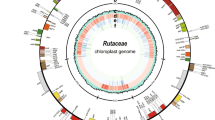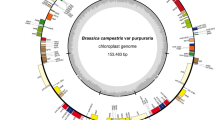Abstract
Hybridization and polyploidization can be major mechanisms for plant evolution and speciation. Thus, the process of polyploidization and evolutionary history of polyploids is of widespread interest. The chloroplast DNA regionsmatK was used to analyze to phylogenetic relationships and maternal donor of Elymus species and their closely related species. The Neighbor-Joining phylogenetic reconstructions partitioned the species into one monophyletic groups. All the Elymus species were related to species of Pseudoroegneria. These results indicated that Pseudoroegneria (St genome) was the maternal donor of the polyploidy Elymus. In addition, the St genome of Elymus had several origins and diverse species of Pseudoroegneria might have taken part in the formation of polyploid species of Elymus.
Similar content being viewed by others
References
Dewey D.R. 1967. Synthetic hybrids of Agropyron scribneri × Elymus juncea. Bulletin of the Torrey Botanical Club. 94: 388–395.
Dewey D.R. 1971. Synthetic hybrids of Hordeum bogdanii with Elymus canadensis and Sitanion hystrix. Am. J. Bot. 58: 902–908.
Dewey D.R. 1984. The genome system of classification as a guide to intergeneric hybridization with the perennial Triticeae, pp.209–279. In: Gustafson J.P. (ed.), Gene Manipulation in Plant Improvement, Plenum, New York.
Dong Z.Z., Fan X. & Sha L.N. 2015. Phylogeny and differentiation of the St genome in Elymus L. sensu lato (Triticeae; Poaceae) based on one nuclear DNA and two chloroplast genes. BMC Plant Biol. 15: 179–192.
Doyle J.J. & Doyle J.L. 1990. Isolation of plant DNA from fresh tissue. Focus 12: 13–15.
Fan X., Sha L.N., Yang R.W., Zhang H.Q., Kang H.Y., Zhang L., Ding C.B., Zheng Y.L. & Zhou Y.H. 2009. Phylogeny and evolutionary history of Leymus (Triticeae; Poaceae) based on a single-copy nuclear gene encoding plastid acetyl-CoA carboxylase. BMC Evol. Biol. 9: 247–262.
Fan X., Sha L.N., Zeng J., Kang H.Y., Zhang H.Q., Wang X.L., Zhang L., Yang R.W., Ding C.B., Zheng Y.L. & Zhou Y.H. 2012. Evolutionary dynamics of the Pgk1 gene in the polyploid genus Kengyilia (Triticeae: Poaceae) and its diploid relative. PLoS One 7: e31122.
Fu Y.X. & Li W.H. 1993. Statistical tests of neutrality of mutations. Genetics 133: 693–709.
Gao G., Deng J.B., Gou X.M., Wang Q., Ding C.B., Zhang L., Zhou Y.H. & Yang R.W. 2015. Phylogenetic relationships among Elymus and related diploid genera (Triticeae: Poaceae) based on nuclear rDNA ITS sequences. Biologia 70: 183–189.
Ge S., Sang T., Lu B.R. & Hong D.Y. 1999. Phylogeny of rice genomes with emphasis on origins of allotetraploid species. Proc.Natl. Acad. Sci. USA 96: 14400–14405.
Hudson R.R. 1990. Gene genealogies and the coalescent process, pp.1–44. In: Futuyma D. & Antonovics J. (eds): Oxford Surveys in Evolutionary Biology, Oxford University Press, New York.
Jensen K.B. 1990. Cytology and taxonomy of Elymus kengii, E. grandiglumis, E. alatavicus and E. batalinii (Triticeae: Poaceae). Genome 33: 668–673.
Liu Q.L., Ge S. & Tang H.B. 2006. Phylogenetic relationships in Elymus (Poaceae: Triticeae) based on the nuclear ribosomal internal transcribed spacer and chloroplast trnL-F sequences. New Phytol. 170: 411–420.
Löve A. 1984. Conspectus of the Triticeae. Feddes Rep. 95: 425–521.
Lu B.R. 1994. The genus Elymus L. in Asia. Taxonomy and biosystematics with special reference to genomic relationships, pp. 219–233. In: Wang R.R.-C., Jensen K.B. & Jaussi C. (eds), Proceedings of the 2nd International Triticeae Symposium. Utah State University Press, Utah.
Mason-Gamer R.J., Burns M.M. & Naum M. 2010. Phylogenetic relationships and reticulation among Asian Elymus (Poaceae) allotetraploids: analyses of three nuclear gene trees. Mol. Phylogenet. Evol. 54: 10–22.
Nei M. & Li W.H. 1979. Mathematical model for studying genetic variation in terms of restriction endonucleases. Proc. Natl. Acad. Sci. USA 76: 5269–5273.
Otto S.P. 2007. The evolutionary consequences of polyploidy. Cell 131: 452–462.
Redinbaugh M.G., Jones T.A. & Zhang Y. 2000. Ubiquity of the St chloroplast genome in St-containing Triticeae polyploids. Genome 43: 846–852.
Rozas J., Sánchez-DelBarrio J.C., Messeguer X. & Rozas R. 2003. Dna SP, DNA polymorphism analyses by the coalescent and other methods. Bioinformatics 19: 2496–2497.
Soltis P.S. & Soltis D.E. 2000. The role of genetic and genomic attributes in the success of polyploids. Proc. Natl. Acad. Sci. USA 97: 7051–7057.
Soltis D.E., Soltis P.S. & Tate J.A. 2003. Advances in the study of polyploidy since plant speciation. New Phytol. 161: 173–191.
Symonds V.V., Soltis P.S. & Soltis D.E. 2010. Dynamics of polyploid formation in Tragopogon (Asteraceae): recurrent formation, gene flow, and population structure. Evolution 64: 1984–2003.
Tajima F. 1989. Statistical method for testing the neutral mutation of hypothesis by DNA polymorphism. Genetics 123: 585–595.
Tamura K., Peterson D., Peterson N., Stecher G., Nei M. & Kumar S. 2011. MEGA5: Moleculare volutionary genetics analysis using maximum likelihood, evolutionary distance, and maximumparsimony methods. Mol. Biol. Evol. 28: 2731–2739.
Thompson J.D., Higgins D.G. & Gibson T.J. 1994. CLUSTAL W: improving thesensitivity of progressive multiple sequence alignment through sequence weighting positions-specific gap penalties and weight matrix choice. Nucleic Acids Res. 22: 4673–4680.
Torabinejad J. & Mueller R.J. 1993. Genome constitution of the Australian hexaploid grass, Elymus scabrus (Poaceae: Triticeae). Genome 36: 147–151.
Wang R.R.C., Dewey D.R. & Hsiao C. 1986. Genomic analysis of the tetraploid Pseudoroegneria tauri. Crop Sci. 26: 723–727.
Watterson G.A. 1975. On the number of segregation sites in genetic models without ecombination. Theor. Popul. Biol. 7: 256–276.
Wendel J.F. 2000. Genome evolution in polyploids. Plant Mol. Biol. 42: 225–249.
Yan C. & Sun G.L. 2012. Multiple origins of allopolyploid wheatgrass Elymus caninus revealed by RPB2, PepC and TrnD/T genes. Mol. Phylo. Evol. 64: 441–451.
Yan C., Sun G.L. & Sun D.F. 2011. Distinct origin of the Y and St genome in Elymus species: evidence from the analysis of a large sample of St genome species using two nuclear genes. PLoS One 6: e26853.
Yen C. & Yang J.L. 2013. Biosystematics of Triticeae. Chinese Agriculture Press, Beijing.
Yu H.Q., Zhang C., Ding C.B., Ma X. & Zhou Y.H. 2010. Maternal donors of polyploids in Pseudoroegneria (Poaceae: Triticeae) and related genera inferred from chloroplast trnL-F sequences. Turk. J. Biol. 34: 335–342.
Zhang C., Fan X., Yu H.Q., Wang X.L. & Zhou Y.H. 2009. Different maternal genome donor to Kengyilia (Poaceae: Triticeae) species inferred from chloroplast trnL-F sequences. Biol. Plant. 53: 759–763.
Author information
Authors and Affiliations
Corresponding author
Rights and permissions
About this article
Cite this article
Gao, G., Deng, J., Zhang, Y. et al. Phylogeny and maternal donor of Elymus (Triticeae: Poaceae) in China based on chloroplast matK sequences. Biologia 72, 595–600 (2017). https://doi.org/10.1515/biolog-2017-0067
Received:
Accepted:
Published:
Issue Date:
DOI: https://doi.org/10.1515/biolog-2017-0067




